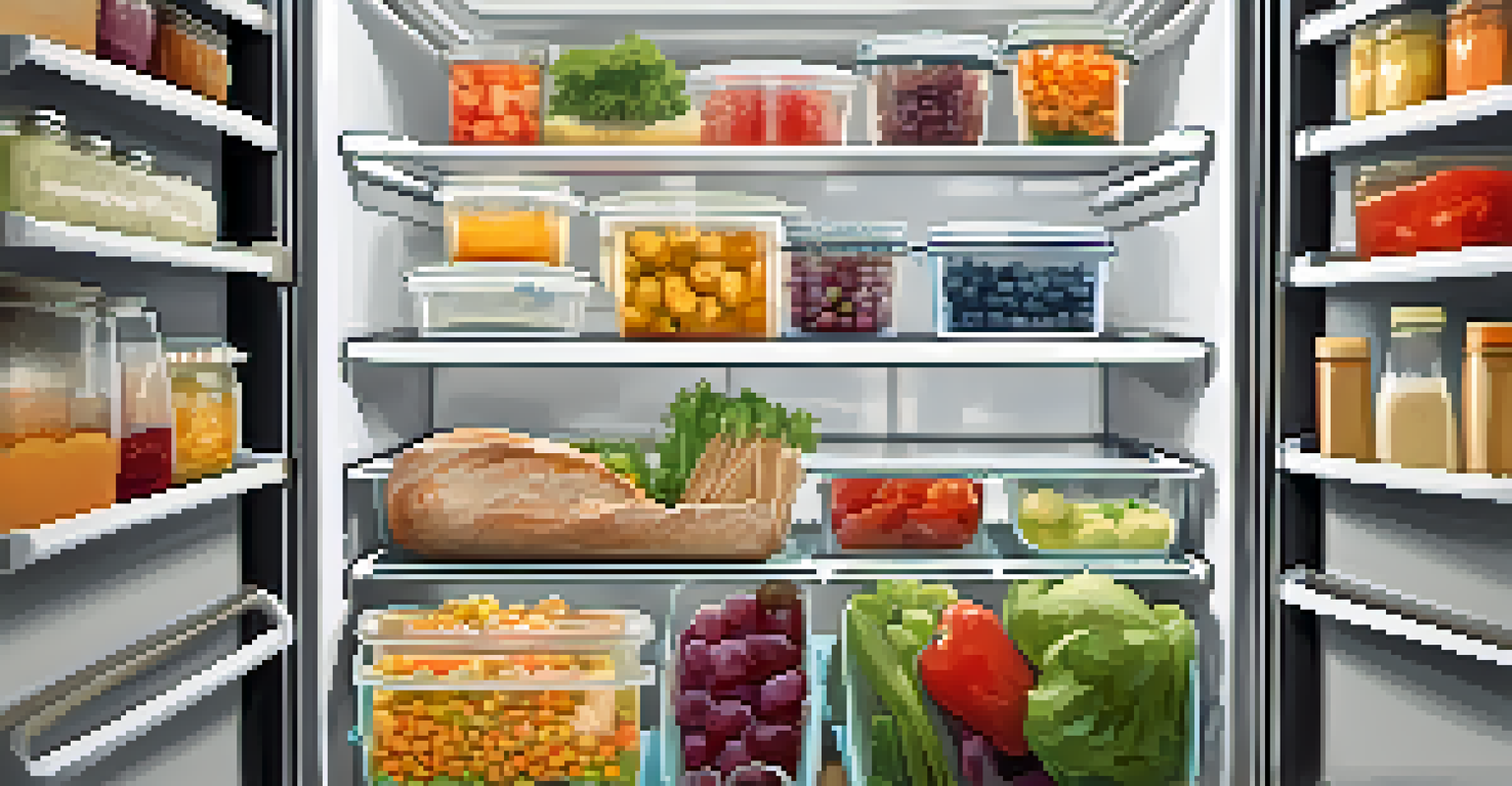Strategies for Effective Meal Planning to Boost Your Health

Understanding the Basics of Meal Planning
Meal planning is the process of preparing meals in advance to save time and promote healthier eating. By taking a few moments to outline what you'll eat for the week, you can make more mindful choices and avoid last-minute fast food runs. This strategy not only helps you stick to your health goals but also reduces food waste and saves money.
By failing to prepare, you are preparing to fail.
Consider starting with a simple template for your meals, such as planning breakfast, lunch, and dinner for each day. This can feel overwhelming at first, but remember that even small steps can lead to big changes. For instance, you might decide to plan just one meal a day initially and gradually increase this as you become more comfortable with the process.
Incorporating variety into your meal plan can also keep things interesting and enjoyable. Try to include different proteins, grains, and vegetables throughout the week, which not only provides essential nutrients but also makes your meals colorful and appealing.
Setting Clear Health Goals for Your Meal Plan
Before diving into meal planning, it's crucial to set clear health goals. Are you looking to lose weight, gain muscle, or simply eat more fruits and vegetables? Defining your objectives can guide your meal choices and make planning much more effective. For example, if you want to eat more plant-based meals, you might focus on incorporating legumes and whole grains into your recipes.

It's helpful to write down your goals and keep them visible, perhaps by posting them on your fridge. This serves as a constant reminder of what you're aiming for and can motivate you to stick to your meal plan. Remember, specific goals like 'I want to eat three servings of vegetables each day' are more actionable than vague ones like 'I want to eat healthier.'
Plan Meals for Healthier Eating
Meal planning helps you make mindful food choices, reduces food waste, and saves money.
As you progress, don’t hesitate to adjust your goals based on your experiences. If you find you’re not enjoying certain foods or recipes, it’s okay to pivot and try something new. Meal planning should be a flexible process that evolves with your tastes and lifestyle.
Choosing the Right Recipes for Your Meal Plan
Selecting the right recipes is a key component of effective meal planning. Look for recipes that align with your health goals and can be easily prepared within your schedule. Websites, cookbooks, and even social media platforms are full of inspiration, so take advantage of these resources. For instance, if you're busy during the week, consider recipes that can be made in 30 minutes or less.
The secret of success is to be ready when your opportunity comes.
Another great strategy is to batch cook larger portions of certain meals that can be stored and eaten throughout the week. Dishes like soups, stews, and casseroles are perfect for this, as they often taste even better the next day. Plus, you save time on cooking and cleaning, allowing you to focus on other important tasks.
Don’t forget to consider dietary preferences and restrictions when choosing recipes. If you're cooking for a family or group, try to find meals that everyone can enjoy, or make slight modifications to accommodate different needs. This not only promotes inclusivity but also ensures that everyone is excited about mealtime.
Creating a Shopping List to Stay Organized
Once your meal plan is set, creating a shopping list is the next crucial step. This list should include all the ingredients you'll need for the week, categorized by food group to make shopping more efficient. For example, you might separate your list into sections for produce, proteins, grains, and dairy, which can save you time in the grocery store.
Having a well-prepared shopping list reduces the temptation to buy items that aren't part of your meal plan, helping you stick to healthier choices. It can also prevent impulse buys that often lead to unhealthy snacking or unnecessary spending. Think of it as your roadmap to healthier eating—without it, you might easily veer off course.
Set Clear Health Goals
Defining specific health objectives guides your meal choices and makes planning more effective.
Additionally, consider shopping from your pantry and fridge before heading out. You might find ingredients that can be used in your meals, reducing waste and saving you money. This approach not only promotes resourcefulness but also encourages creativity in the kitchen.
Incorporating Flexibility in Your Meal Plan
While having a meal plan is essential, it's equally important to build in some flexibility. Life can be unpredictable, and sometimes plans need to change, whether due to a busy schedule or unexpected cravings. Allow yourself the freedom to swap meals around or adjust recipes based on what's fresh and available.
For instance, if you planned to have grilled chicken on Tuesday but feel like pasta instead, don’t hesitate to switch it up. This flexibility can help you stay on track without feeling restricted, making your meal planning experience more enjoyable overall. Remember, the goal is to promote healthier eating, not to create stress.
Additionally, be open to experimenting with new ingredients or cuisines. Trying out a new recipe or dish can be a fun way to keep your meal plan exciting. Consider designating one night a week as 'experiment night' where you try something new, which can lead to delightful surprises in your meals.
Utilizing Leftovers to Maximize Your Meal Plan
Leftovers can be a game changer in meal planning, providing convenience and saving time in the kitchen. Instead of letting extra portions go to waste, think of creative ways to repurpose them into new meals. For example, leftover roasted vegetables can be tossed into a salad or blended into a smoothie for added nutrition.
Planning meals that intentionally create leftovers is another effective strategy. If you know you'll have extra rice or quinoa, think about how you can use it in various recipes throughout the week. This not only minimizes waste but also ensures you have ready-to-eat options on busy days.
Utilize Leftovers Creatively
Repurposing leftovers not only saves time but also reduces waste and provides ready-to-eat meals.
Don't forget about freezing leftovers, too! Many dishes freeze well, allowing you to enjoy them weeks later. Label your frozen meals with dates and contents, making it easy to grab a healthy option when you're short on time.
Tracking Your Progress and Adjusting Your Plan
Tracking your progress is vital for understanding how well your meal planning strategy is working. Consider keeping a journal or using a meal planning app to jot down what you eat and how you feel. This can help identify patterns, such as which meals you enjoy most or which ones you tend to skip.
As you collect data, don’t be afraid to adjust your meal plan based on what you learn. If certain recipes are consistently a hit, incorporate them more often. Conversely, if you find that some meals are not appealing, it’s perfectly okay to change them up or eliminate them from your rotation.

Remember, meal planning is a journey, and it takes time to find a rhythm that works for you. Embrace the process, celebrate your victories, and don't be discouraged by setbacks. The more you track and adjust, the more effective your meal planning will become, leading to a healthier lifestyle.